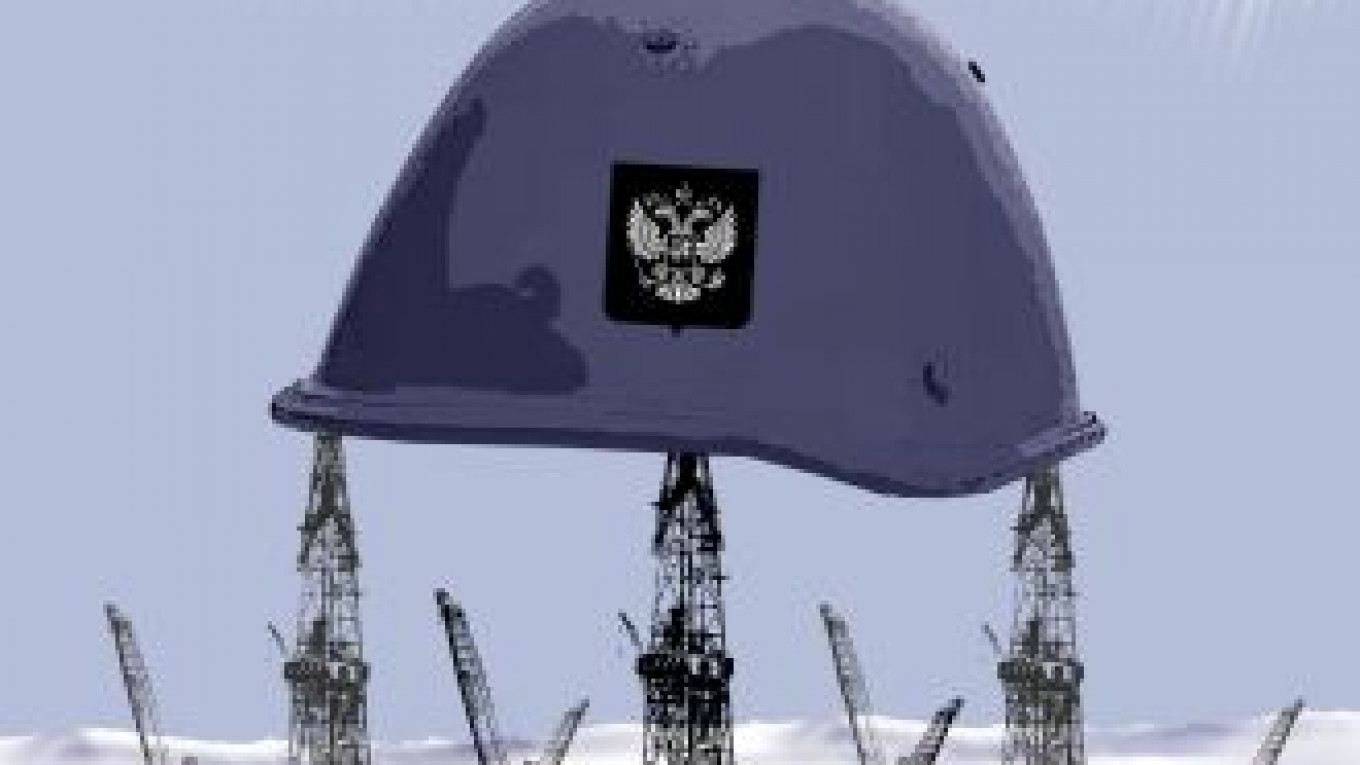The Kremlin is looking increasingly like the factory in the old Soviet joke that could take any sewing machine and turn it into a Kalashnikov rifle. In the same way, no matter which ideas go into the Kremlin, they invariably come out with a militaristic twist. That is exactly what is happening with the development of the Arctic, one of President Vladimir Putin's pet projects.
When questioned about the Arctic during a meeting with United Russia leaders, Putin first mentioned the U.S. submarines in the region with missiles aimed at Moscow and St. Petersburg. Only afterward did he explain that Russia would soon experience a windfall as a result of global warming. It seems that the ice of the Arctic Ocean is rapidly melting, opening up the Northern Sea Route as the shortest maritime link between Europe and Asia. What's more, there are apparently limitless deposits of oil and gas concealed beneath the ocean floor just waiting to be tapped. And it goes without saying that the scheming West will do all it can to spoil Russia's good fortune — making this the time for Moscow to prepare militarily to defend its vital interests in the North.
Putin also pointed out that the Northern Fleet's nuclear-powered missile cruiser Peter the Great, with an escort of 10 ships, had sailed to the New Siberian Islands to deliver materials needed for the reconstruction of an airport on Kotelny Island that had fallen out of use in the 1990s. Tellingly, Putin referred to the handful of barracks there housing antiquated equipment and a company of radar operators as a "Soviet military base."
For some inexplicable reason, Russia's top brass equates the development of the Arctic with its militarization. And yet there is no reason to assume that Russia will get rich from the consequences of global warming. The higher temperatures will also cause the permafrost to melt, turning the northern coastline into an icy slush several kilometers deep and making it impossible to build the infrastructure needed to serve the Northern Sea Route or the structures required to extract the region's oil and gas. What's more, the United Nations Convention on the Law of the Sea prohibits the host country from placing any restrictions on foreign ships passing along the Northern Sea Route. To the contrary, Russia is obligated to provide passing foreign vessels with communications, meteorological, hydrological and rescue services at its own expense — meaning that Putin's dream of cashing in on the route is really only wishful thinking. The only way to profit from the maritime traffic would be to provide pilotage services, icebreaking support vessels and advanced infrastructure services. However, a cursory glance at Russia's Arctic coast is enough to see that the infrastructure there is anything but modern.
Russia itself shipped 1.2 million tons of cargo through the Northern Sea Route in 2012, but it has been estimated that the total would have to reach from 4 million to 14 million tons annually to be profitable. The truth is that economic viability was never a consideration: during the 80 years of its existence, the route has primarily served as a supply line for northern military bases and prisoner camps. Now Russian leaders hope it will become a major transportation artery for offshore oil. However, all major Western oil companies have written off Arctic shelf extraction as too dangerous and expensive and, ships drafting more than 12 meters of water cannot pass through the New Siberian Islands area, making the route unusable for deeper-hulled vessels.
Despite the impassioned pleas of Rosneft chief Igor Sechin and Deputy Prime Minister Dmitry Rogozin, Russian shipbuilding companies have shown little desire to construct icebreakers and drilling platforms. They see that government leaders are more interested in creating the appearance of a military buildup in the Arctic than in actually accomplishing anything there. The likelihood of accomplishing even that task is questionable, considering that all of the country's northern military forces are concentrated on the Kola Peninsula at the far western edge of Russia's Arctic region. They consist of a brigade of Northern Fleet marines, a motorized infantry brigade, two air bases, two anti-aircraft missile regiments and the ship-based personnel of the Northern Fleet. Аpart from a few missile-tracking stations, that is about all there is to guard over the many thousands of kilometers of Russia's vast northern territory stretching from Murmansk in the west to Magadan in the east.
There is a reason Russia's northern military forces are stretched so thin.
The ice over the Arctic Ocean provides convenient cover for both U.S.and Soviet nuclear-powered submarines to launch their nuclear missiles at enemies. This has turned the entire region into a scene of military confrontation between the two countries that dates back to the end of World War II. The main task before the Soviet Union's combined Arctic forces of navy, air force and ground troops was to enable Soviet submarines to patrol against their U.S. counterparts and to protect military bases on the Kola Peninsula. That was a clear and specific military objective that did not extend to controlling and defending the thousands of kilometers of barren ice. The ships of the Northern Fleet cannot function east of Novaya Zemlya due to the absence of bases, ground support and air cover in the area. That is precisely why the naval trek to the New Siberian Islands was hailed as such a heroic feat, even though the establishment of a small airfield there does not change the overall situation. It is not enough to deploy large numbers of aircraft to survey such an immense territory and an equally huge quantity of fuel would be needed to really patrol the area, a task that this campaign showed to be extremely difficult.
Lastly, this symbolic military "buildup" is highly counterproductive from a political standpoint. The U.S., Denmark, Canada, Norway and Russia all have their own interests in the Arctic. This leaves Moscow with plenty of room to maneuver. It can form alliances with some countries or against others while compromising to achieve its aims. However, those diplomatic tactics only work as long as Russia does not create a military threat in the region. If it risks taking that approach, the move would invariably prompt a collective defense response by NATO countries. In that case, instead of defending its interests by building strategic alliances with individual states, Russia would be forced to counter a united front from Western states. The greatest paradox is that Russia only wants to mine the riches buried beneath the Arctic Ocean floor in order to "sell" them at great profit to the very countries it is prepared to threaten with military force.
Alexander Golts is deputy editor of the online newspaper Yezhednevny Zhurnal.
A Message from The Moscow Times:
Dear readers,
We are facing unprecedented challenges. Russia's Prosecutor General's Office has designated The Moscow Times as an "undesirable" organization, criminalizing our work and putting our staff at risk of prosecution. This follows our earlier unjust labeling as a "foreign agent."
These actions are direct attempts to silence independent journalism in Russia. The authorities claim our work "discredits the decisions of the Russian leadership." We see things differently: we strive to provide accurate, unbiased reporting on Russia.
We, the journalists of The Moscow Times, refuse to be silenced. But to continue our work, we need your help.
Your support, no matter how small, makes a world of difference. If you can, please support us monthly starting from just $2. It's quick to set up, and every contribution makes a significant impact.
By supporting The Moscow Times, you're defending open, independent journalism in the face of repression. Thank you for standing with us.
Remind me later.







